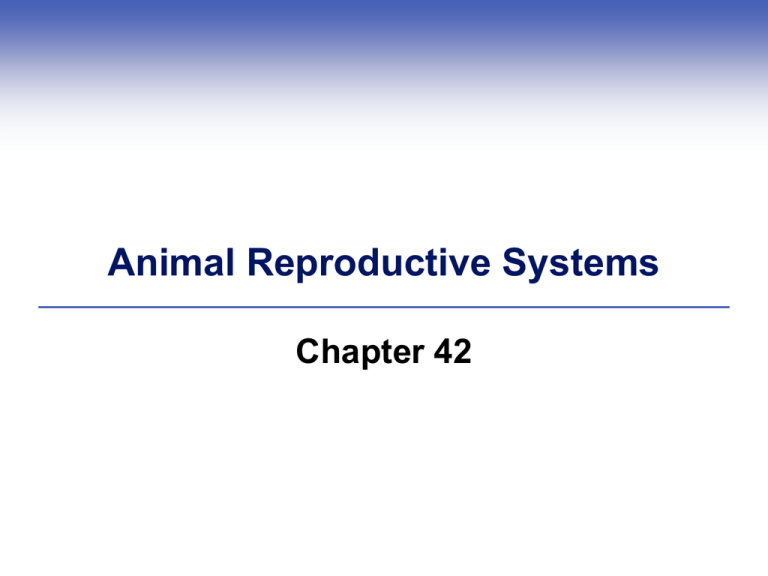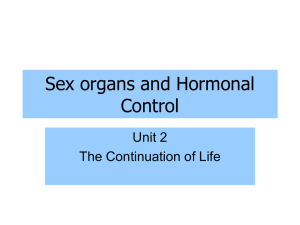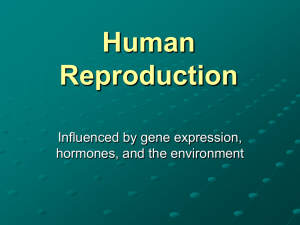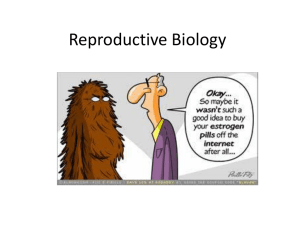
Animal Reproductive Systems
Chapter 42
Impacts, Issues
Male or Female? Body or Genes?
Body and genes don’t always match – male or
female characteristics also depend on hormones
– mutations can result in intersex conditions
42.1 Modes of Animal Reproduction
Sexual reproduction dominates the life cycle of
most animals
Many invertebrates and some vertebrates can
reproduce asexually or sexually
Asexual Reproduction in Animals
Asexual reproduction
• A single individual makes offspring that are
genetically identical to the parent
• Advantageous in a stable environment where a
parent passes on successful gene combinations
Methods of asexual reproduction
• Fragmentation (in many invertebrates)
• Parthenogenesis (from unfertilized eggs)
Costs and Benefits
of Sexual Reproduction
Sexual reproduction
• Two parents make gametes that combine at
fertilization to produce offspring with gene
combinations unlike either parent
• Genetic diversity increases chances of offspring
survival in changing environments
• Genetic and energetic costs are higher than in
asexual reproducers
Variations on Sexual Reproduction
Most vertebrates have separate sexes that are
fixed for life; an individual is either male or female
Some animals produce eggs and sperm at the
same time (simultaneous hermaphrodites), or
produce both at different times in their life
(sequential hermaphrodites)
Eggs: Fertilization and Development
Most aquatic animals have external fertilization;
most land animals have internal fertilization
Internally fertilized eggs may be laid in the
environment or develop in a mother’s body
Egg yolk nourishes developing offspring
• Amount varies with species
• Human eggs are nearly yolkless
Examples of Animal Reproduction
Invertebrate and Vertebrate Parenting
Fig. 42-3a, p. 741
Fig. 42-3b, p. 741
Fig. 42-3c, p. 741
Fig. 42-3d, p. 741
Fig. 42-3e, p. 741
Fig. 42-3f, p. 741
Fig. 42-3g, p. 741
42.1 Key Concepts
Modes of Animal Reproduction
Some animals reproduce asexually, but sexual
reproduction predominates in most animals
Some sexual reproducers make both eggs and
sperm, but most are either male or female
Living on land favored fertilization of eggs inside
the female body
42.2 Reproductive System
of Human Males
The male reproductive system produces
hormones and sperm, which it delivers to a
female reproductive tract
Male gonads (testes)
• Primary reproductive organs in human males
• Produce the male hormone testosterone
• Sperm production begins at puberty
The Path of Sperm
Reproductive ducts
•
•
•
•
Seminal tubules produce immature sperm
Epididymis stores and matures sperm
Vas deferens carries sperm to ejaculatory duct
Ejaculatory duct connects to urethra in the penis
The penis contains spongy tissue which fills with
blood during sexual excitement
Semen and Accessory Glands
Semen
• Sperm and secretions from accessory glands
(proteins, nutrients, ions, signaling molecules)
Accessory glands
• Seminal vesicles secrete fructose-rich fluid (an
energy source) and prostaglandins
• Prostate gland produces alkaline secretions and
prostaglandins
• Bulbourethral glands secret lubricating mucus
Prostate and Testicular Problems
Prostate enlargement
• Can be caused by inflammation, age, or prostate
cancer – a leading cause of death
• Constricts urethra, causing difficulty in urination
• Diagnosed by blood tests, physical examination
Testicular cancer is relatively rare
• Detected by self-examination
Human Male Reproductive System
Ejaculatory Duct
One pair of ducts that
carry sperm
to the penis
Prostate Gland
An exocrine gland
that contributes
some fluid to the
semen
Seminal Vesicle
One of a pair of
exocrine glands that
contributes fructoserich fluid to semen
urinary bladder
Urethra
Duct with dual functions;
channel for ejaculation
of sperm during sexual
arousal and for excretion
of urine at other times
Bulbourethral gland
One of a pair of
exocrine glands
that secrete mucus
anus
scrotum
urethra
cylinders of
spongy tissue that
swell with blood
during an erection
Penis Male
organ of
sexual
intercourse
Vas deferens
One of a pair of
ducts that carry
sperm to the penis
Epydidymis
One of a pair of
ducts in which
sperm mature
and are stored
Testis
One of a pair of gonads, packed
with small, sperm-producing
tubes (seminiferous tubules) and
cells that secrete testosterone
and other sex hormones
Fig. 42-4, p. 742
Animation: Male reproductive system
Human Male Reproductive System
42.3 Sperm Formation
Seminiferous tubules in male testes continually
produce new diploid germ cells (spermatogonia),
which undergo meiosis to produce haploid male
gametes (sperm)
•
•
•
•
•
Spermatogonium
Primary spermatocyte
Secondary spermatocyte
Spermatid
Immature sperm
Sperm Formation
Fig. 42-5a, p. 744
vas
deferens
seminal
vesicle
prostate
gland
bulbourethral
gland
urethra
penis
epididymis
seminiferous
tubule
testis
Fig. 42-5a, p. 744
Fig. 42-5c, p. 744
mitosis
Sertoli
cell
meiosis I
meiosis II
lumen
secondary
early
spermatocyte spermatids
spermatogonium primary
(diploid)
spermatocyte
immature sperm
(haploid)
late
spermatid
Fig. 42-5c, p. 744
Animation: Route sperm travel
Animation: Spermatogenesis
A Spermatozoan
Spermatozoan: a
mature sperm
• Head with DNA and
an enzyme cap
• Midpiece with
mitochondria
• Flagellum for
movement
head, with DNA
and a cap of
enzymes
midpiece with
mitochondria
tail, with
its core of
microtubules
Fig. 42-6, p. 745
Hormonal Control of Sperm Formation
The hypothalamus produces gonadotropin
releasing hormone (GnRH)
GnRH causes the anterior pituitary to secrete
follicle-stimulating hormone (FSH) and
luteinizing hormone (LH)
Hormonal Control of Sperm Formation
LH causes Leydig cells between seminiferous
tubules to produce testosterone
FSH causes Sertoli cells inside seminiferous
tubules to produce growth factors and other
molecular signals
Signaling Pathways in Sperm Formation:
Inhibin and Negative Feedback Control
a Level of testosterone in blood decreases; the
hypothalamus secretes GnRH, a releasing hormone.
Hypothalamus
f Elevated
level of
testosterone
in blood
inhibits
secretion of
GnRH.
g High sperm
count induces
Sertoli cells to
secrete inhibin,
which inhibits
secretion of
GnRH and LH.
Anterior Pituitary
b GnRH stimulates secretion of LH,
FSH from anterior lobe of pituitary.
Testes
c LH prompts Leydig cells d Sertoli cells bind FSH and
in testes to produce and testosterone, and function in
spermatogenesis at puberty.
release testosterone.
e Testosterone and secretions from
Sertoli cells encourage sperm production.
Fig. 42-7, p. 745
a Level of testosterone in blood decreases; the
hypothalamus secretes GnRH, a releasing hormone.
Hypothalamus
f Elevated
level of
testosterone
in blood
inhibits
secretion of
GnRH.
g High sperm
count induces
Sertoli cells to
secrete inhibin,
which inhibits
secretion of
GnRH and LH.
Anterior Pituitary
b GnRH stimulates secretion of LH,
FSH from anterior lobe of pituitary.
Testes
c LH prompts Leydig cells d Sertoli cells bind FSH and
in testes to produce and testosterone, and function in
spermatogenesis at puberty.
release testosterone.
e Testosterone and secretions from
Sertoli cells encourage sperm production.
Stepped Art
Fig. 42-7, p. 745
42.2-42.3 Key Concepts
Male Reproductive Function
A human male has a pair of testes that make
sperm and secrete the sex hormone
testosterone
Sperm mixes with secretions from other glands
and leaves the body through ducts
42.4 Reproductive System
of Human Females
The female reproductive system functions in the
production of gametes and sex hormones
The system receives sperm, and has a chamber
in which developing offspring are protected and
nourished until birth
Location of
the Female Reproductive System
pelvic
girdle
urinary
bladder
uterus
ovary
vagina
Fig. 42-8, p. 746
Components of
the Female Reproductive System
Female gonads (ovaries) secrete sex hormones
and produce immature eggs (oocytes) on a
cyclic basis
Oocytes are released into an oviduct, where
fertilization occurs, before entering the uterus,
where the embryo develops
The vagina functions in intercourse and as the
birth canal
Female Reproductive Organs
Components of
the Female Reproductive System
Ovary
One of a pair of gonads
that makes oocytes
and sex hormones;
during the course of a
monthly cycle, releases
hormones that stimulate
maturation of an
oocyte and prepares
the lining of the
uterus for a potential
pregnancy
Urinary
bladder
Urethra
Clitoris
Small organ responsive
to sexual stimulation
Labium Minora
One of a pair of
innermost thin, skin
folds; part of the genitals
Labium Majora
One of a pair of
outermost, fatpadded skin folds;
part of the genitals
Oviduct
One of a pair of ciliated channels
through which oocytes are
propelled from an ovary to the
uterus; usual site of fertilization
Uterus
Chamber in which embryo
develops; its narrowed
portion, the cervix,
secretes mucus that helps
sperm travel into the
uterus and defends the
embryo against many
bacteria
Myometrium
Thick muscle layers of
uterus; stretch greatly
during pregnancy
Endometrium
Inner lining of the uterus
opening into which a blastocyst
of cervix implants itself; gets
thicker and has increased
blood supply during
pregnancy; gives rise
to maternal portion of
placenta, an organ that
anus
metabolically supports
Vagina
embryonic and fetal
Organ of sexual intercourse;
development
also the birth canal
Fig. 42-9, p. 746
Animation: Female reproductive system
Overview of the Menstrual Cycle
Menstrual cycle
• A hormone-controlled estrous cycle in which a
female is fertile only at certain times
• Every 28 days, an oocyte matures and is released
• The uterus prepares for pregnancy
• If pregnancy does not occur, the endometrial lining
of the uterus is shed (menstrual flow)
Menopause
• Decline of hormone production and menstrual cycle
42.5 Hormones and Female Troubles
Premenstrual syndrome (PMS)
• Changes in aldosterone secretion cause water
retention – also depression, irritability, headaches
Menstrual pain
• Prostaglandins stimulate uterine contractions
• Fibroid tumors cause pain and bleeding
Hot flashes and night sweats
• Side effects of hormonal changes of menopause
42.6 Preparations for Pregnancy
At birth, a girl has about 2 million immature eggs
(primary oocytes) arrested in meiosis I
At puberty, oocytes begin to mature, one at a
time, in a 28-day ovarian cycle
The Follicular Phase
Ovarian follicle
• A primary oocyte and the cells that surround it
Follicular phase
• First part of the ovarian cycle
• Cells around the oocyte divide
• Oocyte enlarges and secretes glycoproteins
Zona pellucida
• Noncellular layer of secreted glycoproteins
An Ovarian Cycle
B The zona pellucida, a
transparent, slightly elastic
layer, starts to form around
primary oocyte.
A A primary oocyte, not yet
released from meiosis I. A
layer of cells is forming
around it. A mature follicle
consists of this cell layer
and the oocyte inside it.
primordial
follicle
C A fluid-filled cavity
starts to form in the
follicle’s cell layer.
first polar
body
ovary
D Mature follicle.
Meiosis I is over.
A secondary
oocyte and the
secondary first polar body
oocyte
have formed.
G If no pregnancy
occurs, the corpus
luteum breaks down.
F A corpus luteum
forms from remains
of ruptured follicle.
E Ovulation. Mature follicle
ruptures, releasing the secondary
oocyte and first polar body.
Fig. 42-10, p. 748
B The zona pellucida, a
transparent, slightly elastic
layer, starts to form around
primary oocyte.
A A primary oocyte, not yet
released from meiosis I. A
layer of cells is forming
around it. A mature follicle
consists of this cell layer
and the oocyte inside it.
primordial
follicle
C A fluid-filled cavity
starts to form in the
follicle’s cell layer.
first polar
body
ovary
D Mature follicle.
Meiosis I is over.
A secondary
oocyte and the
secondary first polar body
oocyte
have formed.
G If no pregnancy
occurs, the corpus
luteum breaks down.
F A corpus luteum
forms from remains
of ruptured follicle.
E Ovulation. Mature follicle
ruptures, releasing the secondary
oocyte and first polar body.
Stepped Art
Fig. 42-10, p. 748
Animation: Ovarian function
Hormonal Controls
Hypothalamus secretes GnRH; the anterior
pituitary increases FSH and LH secretion
FSH and LH stimulate maturation of an ovarian
follicle; the follicle secretes estrogens, which
cause endometrium to thicken
Rising estrogen levels cause a spike in LH,
which stimulates a primary oocyte to complete
meiosis I
Hormonal Controls
The midcycle spike of LH triggers the release of a
secondary oocyte, surrounded by the zona
pellucida, into an oviduct (ovulation)
After ovulation (luteal phase), progesterone
secreted by the ruptured follicle (corpus luteum)
reduces LH and FSH secretion, and promotes
secretion by endometrial glands
Changes in Hormones,
Ovary, and Uterus
Fig. 42-11, p. 749
A FSH and LH levels in blood
FSH
LH
FSH and LH stimulate
Follicle maturation
LH surge
Triggers ovulation
Fig. 42-11, p. 749
Fig. 42-11, p. 749
B Follicle changes in an ovary
follicle matures
ovulation
follicle secretes
estrogens
corpus
luteum
forms
corpus luteum
breaks down
corpus luteum
secretes estrogens,
progesterone
Fig. 42-11, p. 749
Fig. 42-11, p. 749
C Estrogen and progesterone levels in blood
Progesterone
Estrogen
low estrogen
estrogens,
progesterone,
cause uterine
lining to thicken
Fig. 42-11, p. 749
Fig. 42-11, p. 749
D Changes in uterine lining
menstrual
flow
0
2
4
6
8
10
12
14 16
18
20
22
24
26
28
Days of cycle
Follicular phase
Luteal phase
Fig. 42-11, p. 749
Animation: Menstrual cycle summary
If Pregnancy Does Not Occur
The corpus luteum breaks down
Drop in hormone levels causes the endometrial
lining to break down (menstruation)
New follicular phase begins
42.7 FSH and Twins
Typically, only a single egg matures and is
released during each menstrual cycle
Abundant FSH can cause two eggs to mature
and possibly lead to fraternal twins
FSH levels are highest among women of African
descent, and in older women
FSH and Twins
FSH levels and frequency of fraternal twins vary
among ethnic groups – unrelated to chance
formation of identical twins
42.4-42.7 Key Concepts
Female Reproductive Function
A human female has a pair of ovaries that
produce eggs and sex hormones
An approximately monthly hormonal cycle
causes release of eggs
Ducts carry eggs toward the uterus, where
offspring develop
The vagina receives sperm and is the birth canal
42.8 When Gametes Meet
Sexual intercourse (coitus)
• Sexual arousal involves nervous and hormonal
signals; ejaculation releases millions of sperm
into the vagina
Sperm travel through the uterus toward the
oviducts, where fertilization typically occurs
Fertilization
Sperm bind to the oocyte’s zona pellucida,
triggering release of acrosomal enzymes
Penetration by a single sperm causes the
secondary oocyte to complete meiosis II, and
prevents penetration of additional sperm
Sperm organelles disintegrate; sperm and egg
DNA become the genetic material of the zygote
Human Fertilization
Fig. 42-13a, p. 751
oviduct
Fertilization
ovary
Ovulation
uterus
opening
of cervix
vagina
A Fertilization most
often occurs in the
oviduct. Many human
sperm travel swiftly
through the vaginal
canal into oviducts
(blue arrows).
Inside an oviduct,
the sperm surround
a secondary oocyte
that was released by
ovulation.
Fig. 42-13a, p. 751
Fig. 42-13b, p. 751
B Enzymes released from
the cap of each sperm clear
a path through the zona
pellucida. Penetration of
the secondary oocyte by a
sperm causes the oocyte to
releases substances that
harden the zona pellucida
and prevent other sperm
from binding.
oocyte
nucleus
zona
pellucida
follicle
cell
Fig. 42-13b, p. 751
Fig. 42-13c, p. 751
zona
pellucida
haploid egg
and sperm
nuclei
C The oocyte nucleus completes meiosis II, forming a nucleus with
a haploid maternal genome. The sperm’s tail and other organelles
degenerate. Its DNA is enclosed by a membrane, forming a haploid
nucleus with paternal genes. Later, the two nuclear membranes will
break down and paternal and maternal chromosomes will become
arranged on a bipolar spindle in preparation for the first mitotic
division.
Fig. 42-13c, p. 751
Animation: Fertilization
42.9 Preventing or Seeking Pregnancy
Birth control options
• Abstinence (the most effective method)
• Surgical methods (tubal ligation or vasectomy)
• Physical and chemical barriers block sperm
(spermicides, diaphragms, condoms)
• IUDs prevent implantation
• Hormones prevent ovulation (pill, implant)
Common Methods of Contraception
Effectiveness of Contraceptive Methods
Most Effective
Total abstinence
Tubal ligation or vasectomy
Hormonal implant (Norplant)
Highly Effective
IUD + slow-release hormones
IUD + spermicide
Depo-Provera injection
IUD alone
High-quality latex condom
+ spermicide with nonoxynol–9
“The Pill” or birth control patch
Effective
Cervical cap
Latex condom alone
Diaphragm + spermicide
Billings or Sympto-Thermal
Rhythm Method
Vaginal sponge + spermicide
Foam spermicide
Moderately Effective
Spermicide cream, jelly, suppository
Rhythm method (daily temperature)
Withdrawal
Condom (cheap brand)
Unreliable
Douching
Chance (no method)
100%
99.6%
99%
98%
98%
96%
95%
95%
94%
99%
86%
84%
84%
83%
82%
75%
74%
74%
70%
40%
10%
Fig. 42-14, p. 752
After the Fact
Spontaneous or induced abortion terminates a
pregnancy
• About 10% of detected pregnancies end in
spontaneous abortion (miscarriage)
• “Morning-after pills” prevent ovulation
• Abortion may be chemically or surgically induced
Assisted Reproductive Technology
In vitro fertilization
• Eggs and sperm are combined outside the body
• Embryo is implanted into the mother
42.8-42.9 Key Concepts
Intercourse and Fertilization
Sexual intercourse requires coordinating
nervous and hormonal signals
It can lead to pregnancy, which humans use a
variety of methods to prevent, promote, or
terminate
42.10 Sexually Transmitted Diseases
Sexually transmitted diseases (STDs)
• Result of transfer of pathogens in sexually
transmitted body fluids from one host to another
Consequences of infection
• 65 million in US infected with incurable STDs
• Increased risk of infertility or tubal pregnancy
• Transmission from mother to child
Consequences of Infection
New STD Cases Annually
Major STDs
Human papillomavirus (HPV)
• Genital warts, cervical cancer
Trichomoniasis (protist infection)
• Urinary tract damage, infertility, HIV risk
Chlamydia (bacterial infection)
• Pelvic inflammatory disease, infertility
Major STDs
Genital herpes (viral infection)
• Pain and blistering
Gonorrhea (bacterial infection)
• Sterility
Syphilis (spirochete bacterial infection)
• Multiple organ damage
Major STDs
AIDS (Human immunodeficiency virus)
• Destruction of immune system
• Multiple opportunistic infections
Living with HIV: Magic Johnson
Some Agents of Bacterial STDs
Causes of chlamydia, gonorrhea, and syphilis
42.10 Key Concepts
Sexually Transmitted Diseases
A variety of pathogens make their home in the
human reproductive tract; they are passed
between partners by sexual interactions and
may be transmitted to offspring during childbirth
Effects of sexually transmitted diseases range
from discomfort to death
Animation: Follicular phase
Animation: Hormonal control of sperm
production
Animation: Hormones and the menstrual
cycle
Animation: Ovulation and luteal phase
Animation: Where embryos develop








